The Energy Wise Home
The Energy Wise Home
Practical Ideas for Sustainable Living
Jeff Dondero
Rowman & Littlefield
Lanham Boulder New York London
Published by Rowman & Littlefield
A wholly owned subsidiary of The Rowman & Littlefield Publishing Group, Inc.
4501 Forbes Boulevard, Suite 200, Lanham, Maryland 20706
www.rowman.com
Unit A, Whitacre Mews, 26-34 Stannary Street, London SE11 4AB
Copyright 2017 by Jeffrey S. Dondero
All rights reserved . No part of this book may be reproduced in any form or by any electronic or mechanical means, including information storage and retrieval systems, without written permission from the publisher, except by a reviewer who may quote passages in a review.
British Library Cataloguing in Publication Information Available
Library of Congress Cataloging-in-Publication Data
Names: Dondero, Jeff, 1947 author.
Title: The energy wise home : practical ideas for sustainable living / Jeff Dondero.
Description: Lanham : Rowman & Littlefield, 2017. | Includes index.
Identifiers: LCCN 2016049121 (print) | LCCN 201604960 (ebook) | ISBN 9781442279476 (cloth) | ISBN 9781442279483 (ebook)
Subjects: LCSH: DwellingsEnergy conservationHandbooks, manuals, etc.
Classification: LCC TJ163.5.D86 D66 2017 (print) | LCC TJ163.5.D86 (ebook) | DDC 644dc23
LC record available at https://lccn.loc.gov/2016049121
 The paper used in this publication meets the minimum requirements of American National Standard for Information SciencesPermanence of Paper for Printed Library Materials, ANSI/NISO Z39.48-1992.
The paper used in this publication meets the minimum requirements of American National Standard for Information SciencesPermanence of Paper for Printed Library Materials, ANSI/NISO Z39.48-1992.
Printed in the United States of America
Acknowledgments, Dedication, and Disclaimer
T he author wishes to thank the many people who assisted in the creation of this book. First, for her long-standing and patient assistance, and for being my angel in many forms, I thank Alicia Dondero. A boys best friend really can be his mother.
Thanks to Patrick Totty for advice, confidence, encouragement, and aid in many ways, and to Chris Dondero for taking time to consume large chunks of copy in an effort to edit information and offer feedback. Likewise, my thanks go to Tammie Schmidt for wading through copy editing, and also coming to the rescue for many things computational, and to Ginja the Ninja for the exercise.
Thank you to my online editor Kathryn Knigge who, unflaggingly, and with deference and patience, was essential in getting this large undertaking in order, and to the publisher for giving me the opportunity for others to read what I write. Finally, thanks to all my pals who plied me with confidence and the occasional cocktail.
Last but not in the least, thanks to all the people who write books, put together information, struggle with statistics, make maps, create charts and tables to clarify, quantify, and illuminate the world for others.
Disclaimer
It is important to remember, There are lies, damn lies, and statistics. Most of the stats here have been gathered by local, state, and federal government agencies, independent scientists and writers, power companies, universities, various water and power companies, the Internet, and other informed sources. Consequently, I do not claim that all the statistics presented represent accurate and true statements, percentages, and facts, and I do not warrant or make any representations as to the content, accuracy, or completeness of the information, text, graphics, charts, Web links, Web sites, and other items contained in their media presentations.
Aggregating and writing information for this kind of book has its inherent problems and predicaments. When presented with questions, people use different ways to find diverse answers and conclusions. Consequently answers may vary, sometimes quite a bit. For example, prices for fuel and/or power can change not only from various utility companies, but also from state to state, and can fluctuate due to availability and demand. Opinions on how much water a family of four uses, or even an individuals survival needs, range quite a bit. Also, the results of certain criteria can be altered by many factors, depending on weather, location, cost of resources, size of home, etc. In addition, some of the facts presented might be affected by time, changing world events, or new discoveries.
Not all scientists would agree on matters such as global warming, climate change, or the fact that CO is contributing to the detriment of our environment. What I have tried to do is present an informed opinion about what the future might hold for the Earth. I have also stated that there have been many doomsayers that may have made dire predictions about the fate of the Earth that have not come to pass. As in many things, opinions vary as to number, percentages, predictions, and the veracity or divergence of the results obtained by individuals using the same information. No one can completely and accurately predict the future, but what we can do is err on the side of caution and plan for a more secure, healthy, and progressive one.
Although most of the facts presented herein are defensible, I use them as literary, entertainment, and educational devices to give the reader a general perspective on the subject of resources and energy used in our homes. In an effort to communicate more easily and effectively I have taken averages, mean numbers, sometimes common sense, and have modified statements to reflect more than one, set opinion and/or I have updated them. However, we have tried to make this book as clear and concise as possible.
Legally it would be put in another way: Neither the writer, the publisher, nor any of their employees makes any warranty, or guarantee, express or implied, or assumes any legal liability or responsibility for the accuracy, completeness, or usefulness of any information, percentage, apparatus, product, device, or process disclosed, or represents that its use would not infringe privately owned rights. Reference herein to any specific commercial copyright, product, process, or service by trade name, trademark, manufacturer, or otherwise, does not necessarily constitute or imply its endorsement or recommendation. The views and opinions of authors expressed herein do not necessarily state or reflect those of Rowman & Littlefield Publishing or its agents. The information and/or products mentioned herein do not imply an endorsement, guarantee, or warranty. This book is for entertainment and educational purposes only.
Your Home
And Its Appetites
W hen people receive the inevitable and somewhat bothersome monthly visitorstheir water and power billsmany wonder what does this mean and where does all that money go? These days people have a lot more things that cost a lot to run and maintain. Think of the house as a very large and complex machine that should run efficiently and be maintained properly when it comes to energy. Our aim is to tune up that machine and ease the burden of climate change while shrinking the size of your monthlies, and to live a little more lightly and slightly.
The good news is that the big energy suckers in your homeair conditioner, refrigerator, clothes washer, and even light bulbshave become far more efficient. Compared with 1980 models, clothes washers now use 70 percent less electricity. New LED light bulbs use 80 percent less, and refrigerators use 60 percent less power.
Compared to newer homes, those built before 1980 tend to be poorly insulated and leak a lot of energy like poorly constructed cottages and drafty castles. The comfort and condition of the family home and wallet can be improved by remembering energy conservation, checking water systems, insulation, keeping a watch on the kitchen and bathroom appliances, creating more efficient lighting, heating, and cooling, improving ventilation, eliminating drafts and moisture levels in winter, and reducing attic temperatures in summer.
Next page
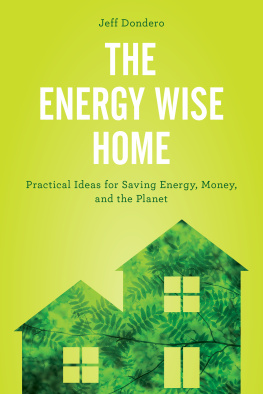
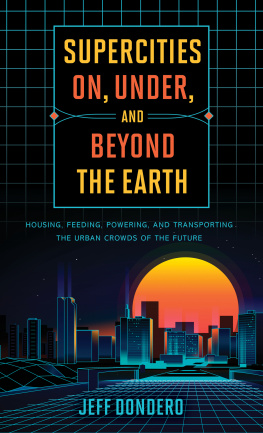
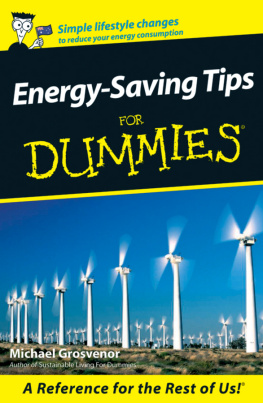
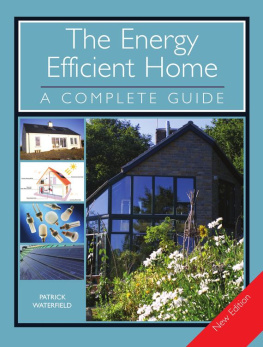



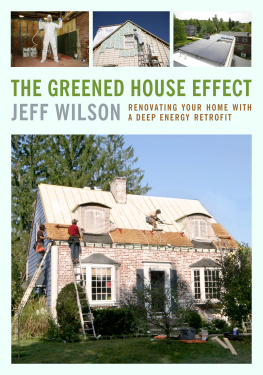
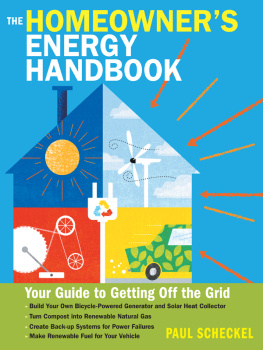
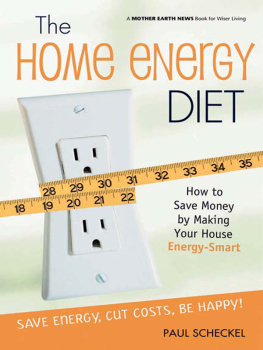

 The paper used in this publication meets the minimum requirements of American National Standard for Information SciencesPermanence of Paper for Printed Library Materials, ANSI/NISO Z39.48-1992.
The paper used in this publication meets the minimum requirements of American National Standard for Information SciencesPermanence of Paper for Printed Library Materials, ANSI/NISO Z39.48-1992.